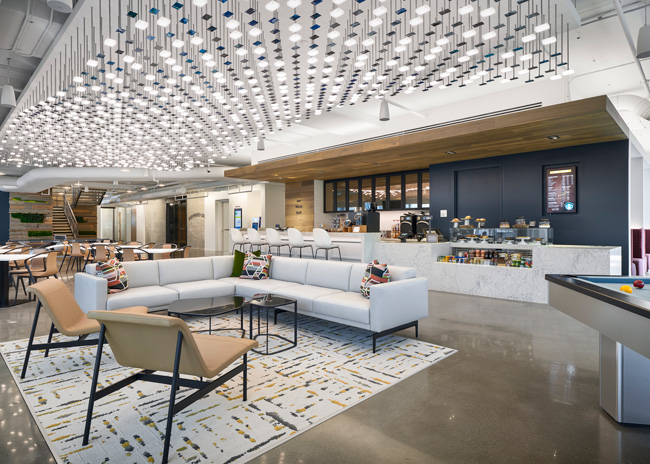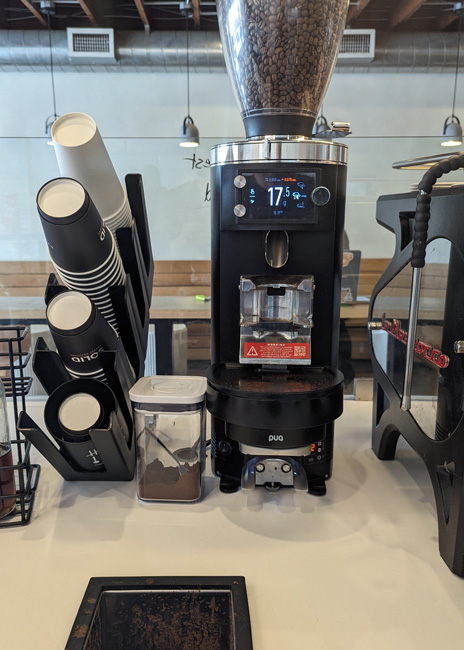Common themes driving all coffee station designs include space, ergonomics and efficiency.
Coffee stations can take on different iterations, depending on the concept. But whether located out front for self-service, tucked away in the kitchen or on display for full-service concepts, coffee stations all share similar design objectives.
“When out of guests’ sight, service needs to be fast. And with self-serve, speed and ease of use are key,” says Michael P. Salvatore III, senior director, consulting and customer engagement, at Ruck-Shockey Associates Inc., which has offices in Truckee, Calif., and The Woodlands, Texas.
It’s also important to look at the operation’s or customer’s level of sophistication in terms of design, along with the space available, says Gregg Golem, founder, Interactive Restaurant Consulting Inc., Thousand Oaks, Calif. This will help determine the best production method.
“There are coffee makers that use grounds and a decanter for serving, which provides a shelf life of about 20 minutes,” Golem explains. “Then there is the method where coffee is brewed into an airpot of varying sizes, which has a couple hours of shelf life. The third method uses soft heat with a warmer and thermal dispenser. It’s important to ask which method fits their vision.”
For coffee cafes where the barista serves as the center of production, incorporating a manual espresso machine in full view of customers means theater trumps speed. “If a customer is going to a nice craft cocktail bar, they want to engage with the bartender, and the same is true with baristas at coffee cafes,” says Garret Sletten, principal at Denver-based Ricca Design Studios. “This provides an opportunity to talk about where beans came from and roasting flavor, so customers understand what they’re drinking and see the process. Guests are willing to wait longer for coffee if they’re seeing it made in front of them.”
Also, consider what coffee variations will be available when developing a design. “Of course, there is always traditional hot coffee, espresso, cappuccino and Americanos, but now customers are requesting cold brew and nitro cold brew on tap, along with iced coffee,” Sletten notes. “Blended coffee drinks are up and coming, and kombucha is very popular with the tea crowd and offered on tap more, as well.”
 The coffee program integrates seamlessly with the high-end design of the space at Half Moon Resort Jamaica. Photo courtesy of Ricca Design Studios
The coffee program integrates seamlessly with the high-end design of the space at Half Moon Resort Jamaica. Photo courtesy of Ricca Design Studios
Design Differences
Though design goals may be similar, coffee station layouts can run the gamut, depending on the concept. Solid Coffee Roasters uses two very different layouts at its two retail locations outside of Los Angeles. “Our Bellflower location is in a shipping container, while the Artesia location is a traditional retail store,” says retail director Ernesto Banderas. “Both offer standard menus, such as drip coffee, espresso, cappuccino, lattes and seasonal specials.”
At the Artesia location, a retail shelf with non-food merchandise like mugs sits to the right of the point-of-sale area. This retail display is adjacent to the empty cups and syrups. Next in line is a grinder with auto tamper, which is by the espresso machine. Refrigeration is under the counter. Once a customer places an order, the order taker preps the cups with the customer’s name and beverage type. The marked-up cup then moves to the barista, who prepares the drink.
“It’s conveyor belt-type action,” Banderas explains. “By comparison, the container store is very tight and accommodates only two people. Orders move from right to left, and the person on the espresso machine also grinds beans, makes the drink and passes it to the customer.”
Banderas prefers to have all equipment, utensils and cups within arm’s reach. He also notes that everything should be accessible to people of average height. “On my left, I like to have the grinder and cups, then I can grab beans and move left to right,” he explains. “Steam is on the right side, and with syrup and cups in one location, there isn’t much turning around, which makes it more labor intensive.”
Solid Coffee Roasters’ pour-over station is at a different table that is separate from the main line. “Employees need to monitor the drink as it’s being made because this type takes more skill and effort,” Banderas says. “But we don’t get many pour-over orders, so this station is not constantly in use.” The pour-over station contains two electric kettles, two scales for measuring coffee, two pour-over sets and a grinder.
“Having like items together is key,” says Tiara Strahan, foodservice/retail manager, of Kay Kafe, part of St. Jude Children’s Research Hospital, Memphis, Tenn. “Functionality should be feasible for the baristas.”
Situated by the medical offices as opposed to the hospital, the design of St. Jude’s first location allows it to push out large volumes. It includes two espresso machines and a large brewer that can prepare four coffee orders at one time.
“Here, we have two main bars — an espresso bar and behind that on a separate counter is the brewer,” Strahan explains. “We also have a separate cold bar station with two blenders as well as a speed oven in the front and back of house for warming up pastries.” A 10-foot pastry case with a cooler on top is out front, which houses grab-and-go food and beverages.
Kay Kafe’s hospital campus location has the same layout and equipment; the only differences are that there is one speed oven and non-food merchandise is offered. “The key for design at this site is a smooth transition to go from the lobby to point of sale to the hand-off area,” Strahan says. “We have to think about families with toddlers, strollers and wagons in tow.”
As a result, this location is undergoing a front-of-the-house facelift, transitioning from island displays to built-in shelving. This will create more floor space for families to maneuver. “Initially we thought that the off-campus store, which was built five years ago, would be our busiest, but that’s not the case,” Strahan notes. “We don’t push through the volume for the equipment we currently have and use the second speed oven and blender sparingly.” She explains that relocating this equipment to the back of house now keeps the counter cleaner with more space to work and a better flow.
 A sleek design integrates this coffee offering into an employee space at a corporate headquarters building. Photo courtesy of Ricca Design Studios
A sleek design integrates this coffee offering into an employee space at a corporate headquarters building. Photo courtesy of Ricca Design Studios
Primary Considerations
The venue, menu and space size will determine design direction, Golem says. The design should also take into account other beverage offerings and the related equipment needs.
In terms of size, Sletten says back-of-the-house coffee stations range from 500 to 700 square feet on average.
“We don’t want the space to be too crowded or try to put too much in a tiny footprint,” Golem notes. “We need enough room for staging and maneuvering as well as cups.”
Operators should also assess water quality to determine filtering needs. “Most will have a reverse osmosis system, and room is needed for water lines,” Golem says. In addition to water filtration and a water line, adequate power and storage — both ambient and refrigerated — are necessary.
Looking at the production as a whole provides insight into equipment and supply needs. With espresso drinks, a bin or scoop is needed to load beans into the grinder before the grounds go into a tapper. “So, the design starts by looking at the coffee supply and grinders,” Golem says. “Then there’s the espresso machine and milk steamer with froth. Generally, right below that is a reach-in refrigerator for backup milk and non-milk products.”
Adjacent to the grinder, a knock box next to a trash can is common for disposal of espresso grounds. Also, a dump sink should be nearby to rinse out coffee grounds from equipment components and utensils.
“Because we don’t want to interrupt the line to grab food, we will build display cases 42 inches tall [so they are out of the way],” Golem explains.
It’s also important to note that pickup stations must be compliant with the Americans with Disabilities Act at 34 inches high, while the front counter should be 4½ to 5 feet wide, which ensures there is enough space for orders, Golem says.
Salvatore notes that design considerations must include space for mugs, cups, saucers, spoons, sweeteners, caddies and trays, in addition to enough room for refrigerated dairy and non-dairy creamers. While back-of-the-house coffee lines are more utilitarian, aesthetics, safety and ergonomics need to be considered for self-service and customer-facing stations. “These areas need to be intuitive for customers, with good signage and everything at waist to chest height,” Salvatore says.
In self-serve coffee stations, the layout and logistics should be top of mind. These counters typically measure between 20 and 30 feet long. As a rule of thumb, Salvatore locates coffee cups and lids in the center, black coffee brewers to the right and condiments to the left. “It depends on the space, but if it’s limited, I put the basics in one area and use a separate table across from where coffee is to hold easily accessible condiments, either bulk or individual,” he says. “There should be room for two to three people [in these stations] as well as a trash can nearby.”
Equipment needs vary, depending on whether the coffee station is located in the front or back of house. “There won’t be an espresso maker in a self-serve station, but there may be an all-in-one coffee machine with a touch screen,” Salvatore says.
Essential Equipment
 The efficient layout at Solid Coffee Roasters includes a knock box next to the grinder for disposal of espresso grounds.“Kitchens will require ice makers, refrigerators, dry storage, everything you don’t want in the front of house,” Sletten says. “Customer-facing stations include hand and dump sinks, displays above, storage below, espresso stations, pastry display, a pickup counter and POS station.”
The efficient layout at Solid Coffee Roasters includes a knock box next to the grinder for disposal of espresso grounds.“Kitchens will require ice makers, refrigerators, dry storage, everything you don’t want in the front of house,” Sletten says. “Customer-facing stations include hand and dump sinks, displays above, storage below, espresso stations, pastry display, a pickup counter and POS station.”
Sletten notes the most critical components are an ice maker, grinder, espresso machine and rinser if frothing milk with steam. Pour-overs don’t need a water line. “Undercounter refrigeration is very important as are hand sinks and the POS station,” he says. “When filtering water for coffee brewing, you need the best water possible, so a decent filter is key. Also, a blender should be included for other beverages, such as smoothies.”
Robotics is an up-and-coming technology that provides further automation benefits. “These machines are loaded and maintained by one person for the day and make drinks any way that is needed,” Salvatore says. “Some even roast.” He adds that although this equipment is not fast, it saves labor and provides consistency.
With coffee stations, successful designs depend on the appropriate equipment to handle volume along with well-organized layouts that require minimal steps.



